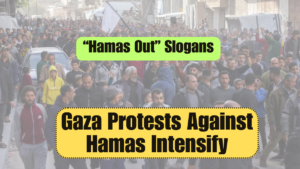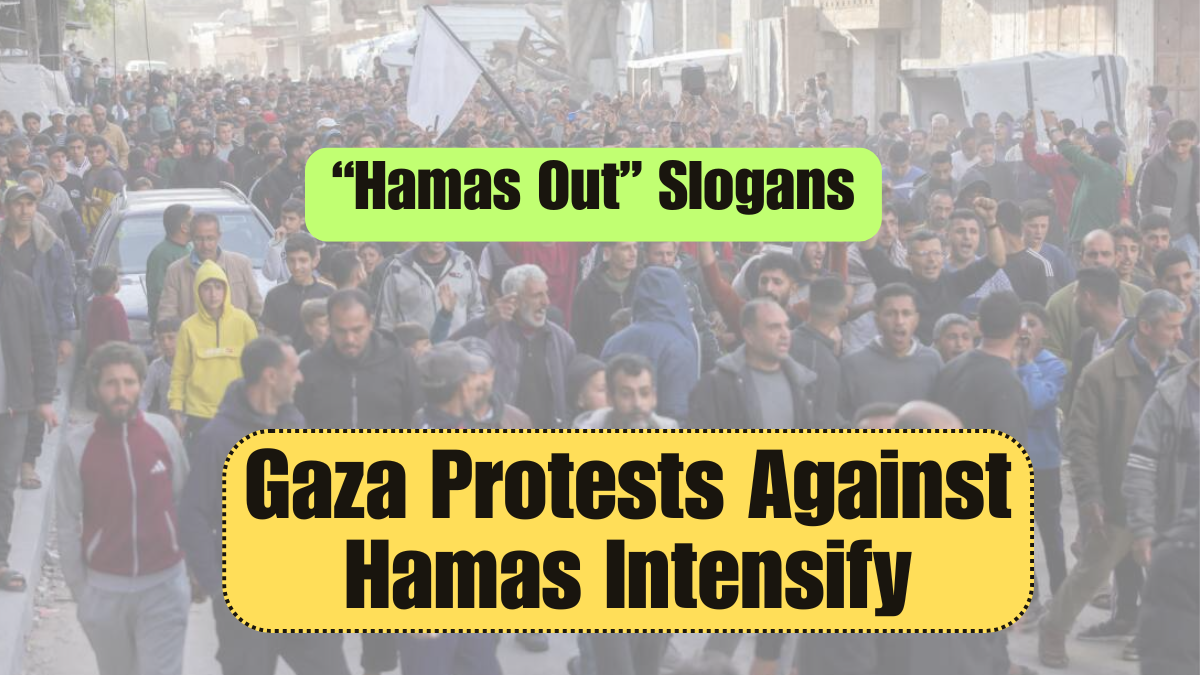In a powerful and rare public uprising, hundreds of Palestinians in Gaza took to the streets on Tuesday night, protesting against the Hamas government that has ruled the territory since 2007. The largest anti-Hamas protest since the latest war with Israel began occurred in Beit Lahia, northern Gaza, where civilians openly chanted slogans like “Hamas out” and “We want to live in peace.”
The protest came just days after the Israeli military resumed its offensive in the region, ending a temporary truce. Amid renewed airstrikes, economic collapse, and dwindling supplies, people have turned their anger toward Hamas, demanding an end to the war and the militant group’s political dominance.

Social Media Footage Reveals the Scale of Public Anger
Videos and photos circulating online showed hundreds of men holding placards and chanting against Hamas. Many banners read “Stop the war”, and “We want peace”, while Telegram channels spread calls for more such demonstrations.
In one video, shared by Al Arabiya, protestors were seen marching through Beit Lahia, denouncing Hamas as “terrorists” and demanding the end of their rule. The chant “Hamas Out” echoed across multiple neighborhoods.
Hamas Responds With Force to Disperse Protestors
Despite the peaceful nature of the protest, masked Hamas operatives were seen violently dispersing the crowd. Some were armed with guns and batons, while others disguised in civilian clothing infiltrated the crowd and allegedly assaulted participants.
Eyewitnesses described the crackdown as brutal. One protestor, identified only as Mohammed, told AFP that he joined the demonstration to say, “Enough with the war.” Another man named Majdi added, “People are tired. We are hungry. We are scared. We want to live.”
Protests Spread to Other Parts of Gaza
The unrest was not limited to Beit Lahia. Protest footage from Jabalia refugee camps and Khan Yunis revealed similar scenes. Dozens of residents, including women and children, were seen burning tyres and shouting that Hamas must step down.
Chants like “The people want Hamas to fall” and “We need food” echoed through the alleys, indicating how severe the humanitarian crisis has become since Israel tightened its blockade earlier in March.
Telegram messages from anonymous accounts continued to circulate on Tuesday evening, calling for more protests on Wednesday across the Gaza Strip.
A Brief Overview of Hamas’ Rule in Gaza
Hamas seized power in Gaza in 2007 following a violent conflict with Fatah, the faction currently leading the Palestinian Authority. Since then, Hamas has maintained control over the territory despite occasional internal dissent and international isolation.
Though the group retains a strong support base in Gaza, dissatisfaction has surged in the wake of Israel’s ongoing military campaign. Economic devastation, collapsed infrastructure, and food insecurity have become daily realities for civilians.
As per a Palestinian Center for Policy and Survey Research (PCPSR) poll from September, 35% of Gazans supported Hamas, while 26% backed Fatah—but these numbers may have shifted given the recent protests and escalating suffering.
Fatah Calls for Hamas to Step Down
In a recent statement, Fatah spokesperson Monther al-Hayek urged Hamas to step aside from governing Gaza to safeguard the future of the Palestinian people. The statement added to international and regional calls urging Hamas to allow for humanitarian aid and alternative governance.
Israel, on its part, has consistently urged Gazans to resist Hamas rule and place blame for the devastation squarely on the group.
Casualties Mount as War Continues
The protests come against the backdrop of mounting casualties. According to the Hamas-run Gaza Health Ministry, more than 50,021 Palestinians, mostly civilians, have been killed in Gaza since Israel launched its retaliatory offensive following the October 7, 2023 Hamas attack, which killed 1,218 people in Israel.
Since the truce collapsed, 792 more Palestinians have reportedly been killed, as Israel blocked humanitarian aid to pressure Hamas into releasing remaining hostages.
Conclusion
The “Hamas Out” protests in Gaza mark a dramatic turning point in public sentiment within the war-torn territory. For the first time in years, widespread demonstrations are openly challenging Hamas’ leadership and demanding peace and stability. Despite violent crackdowns and fear of reprisals, civilians are speaking out, driven by hunger, grief, and desperation. These protests underscore the deepening humanitarian crisis and the growing call for political change in Gaza. As the war rages on, the world watches to see whether this wave of dissent signals a broader shift in the region’s complex and tragic history.
Click here to know more.
